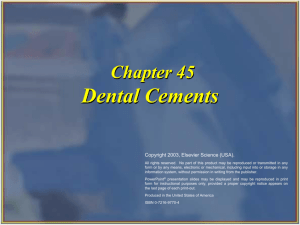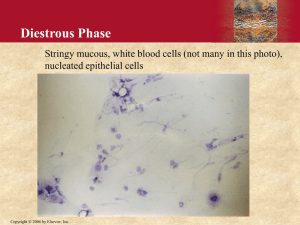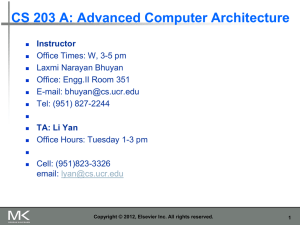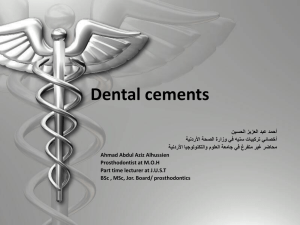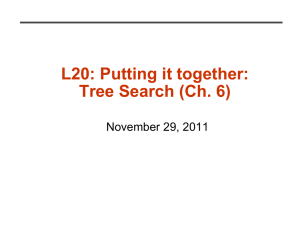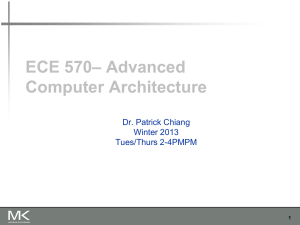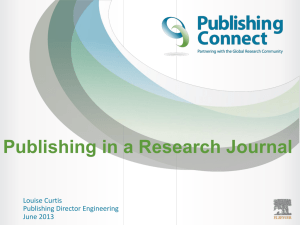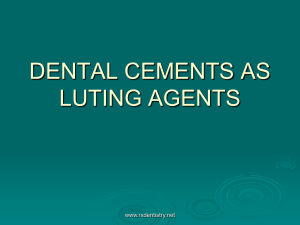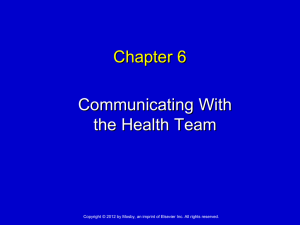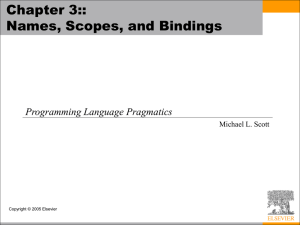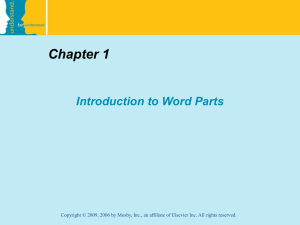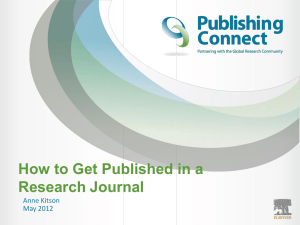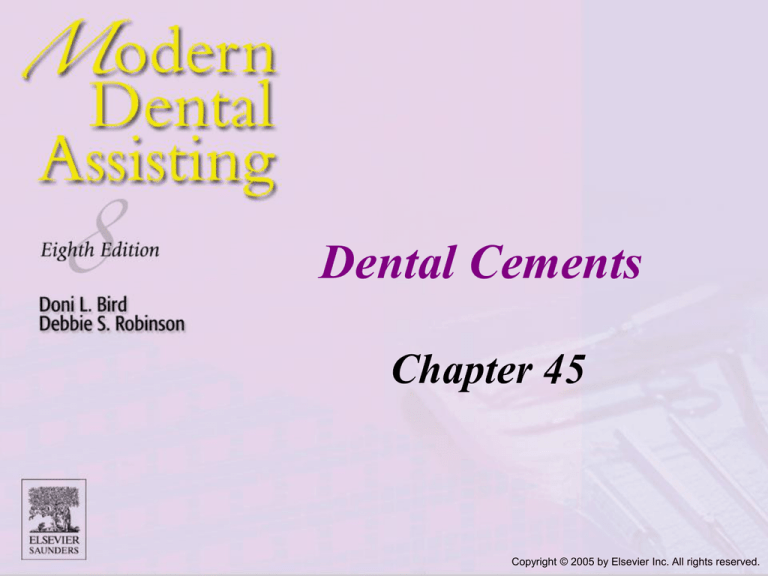
Dental Cements
Chapter 45
Copyright © 2005 by Elsevier Inc. All rights reserved.
Introduction
Dental cements are a classification of
dental materials that are routinely used
when working with indirect restorations.
Copyright © 2005 by Elsevier Inc. All rights reserved.
Classification of Cements
• Type I
– Luting agents which include permanent and
temporary cements
• Type II
– Restorative materials such as glass ionomers
• Type III
– Liner or bases placed with the cavity preparation
Copyright © 2005 by Elsevier Inc. All rights reserved.
Luting Agent
• Type I dental cements that act as an
adhesive to hold together the casting
to the tooth structure
– Luting agents are designed to be either
permanent or temporary.
Copyright © 2005 by Elsevier Inc. All rights reserved.
Fig. 45-1 Casting ready to be cemented
Copyright © 2005 by Elsevier Inc. All rights reserved.
Permanent Cement
For the long-term cementation of
gold and ceramic restorations such
as inlays/onlays, crowns, bridges,
veneers, and orthodontic
fixed appliances.
Copyright © 2005 by Elsevier Inc. All rights reserved.
Temporary Cement
Temporary cements are used if the
restoration would have to be removed
due to sensitivity or other symptoms,
and for the temporary cementation of
provisional coverage.
Copyright © 2005 by Elsevier Inc. All rights reserved.
Variables Affecting Cements
Mixing Time
• Before mixing, follow the manufacturer's directions
• Measure the powder and liquid according to the
intended use
• Separate powder and the liquid to allow space for
mixing
• Divide the powder into increments.
• When increment sizes vary, the smaller increments
are incorporated first
• Incorporate each powder increment into the liquid
and then mix thoroughly
Copyright © 2005 by Elsevier Inc. All rights reserved.
Variables Affecting Cements-cont’d
• Humidity
– If warm or humid, premature exposure to these
environments can create a loss of water from the
liquid or addition of moisture to the powder.
• Powder to Liquid Ratio
– Incorporating too much or too little powder will alter the
consistency.
• Temperature
– Some cements will have an exothermic reaction.
Copyright © 2005 by Elsevier Inc. All rights reserved.
Types of Cements
Zinc-Oxide Eugenol
Zinc Phosphate
Polycarboxylate
Glass Ionomer
Composite Resin
Copyright © 2005 by Elsevier Inc. All rights reserved.
Zinc Oxide Eugenol
• Chemical Makeup
– Liquid: Eugenol, H2O, acetic acid, zinc acetate,
and calcium chloride.
– Powder: Zinc oxide, magnesium oxide,
and silica.
Copyright © 2005 by Elsevier Inc. All rights reserved.
Types of Zinc-Oxide Eugenol
• Type I
– Lacks strength and long-term durability and is
used for temporary cementation of provisional
coverage
• Type II
– Has reinforcing agents added for the
permanent cementation of cast restorations
or appliances
Copyright © 2005 by Elsevier Inc. All rights reserved.
Fig. 45-3 Type I ZOE cement
Copyright © 2005 by Elsevier Inc. All rights reserved.
Fig. 45-4 Type II ZOE cement
Copyright © 2005 by Elsevier Inc. All rights reserved.
Supply of Zinc-Oxide Eugenol
• Type I (Paste)
– Supplied as a two-paste system as
temporary cement.
– Pastes are dispensed in equal lengths
on a paper pad and mixed.
• Type II (Liquid/Powder)
– Mixed on an oil-resistant paper pad.
– Mixing time ranges from 30 to 60 seconds.
– Setting time in the mouth ranges from
3 to 5 minutes.
Copyright © 2005 by Elsevier Inc. All rights reserved.
Zinc Phosphate
• Chemical Makeup
– Liquid: Phosphoric acid, aluminum phosphate,
and water
– Powder: Zinc oxide, magnesium oxide,
and silica
Copyright © 2005 by Elsevier Inc. All rights reserved.
Types of Zinc Phosphate
• Type I (fine grain)
– Used for the permanent cementation of cast
restorations such as crowns, inlays, onlays, and
bridges. This material creates the very thin film
layer necessary for accurate seating of castings .
• Type II (medium grain)
– Recommended for use as an insulating base for
deep cavity preparations.
Copyright © 2005 by Elsevier Inc. All rights reserved.
Supply of Zinc Phosphate
• Type I (Powder/Liquid)
1. Powder is divided into increments varying
in size.
2. It is critical that the powder be added to the
liquid in very small increments.
3. Cement must be spatulated slowly over a
wide area of a cool, dry, thick glass slab to
dissipate the heat.
Copyright © 2005 by Elsevier Inc. All rights reserved.
Fig. 45-5 Zinc phosphate cement
Copyright © 2005 by Elsevier Inc. All rights reserved.
Polycarboxylate Cements
• Chemical Makeup
– Liquid: Polyacrylic acid, itaconic acid, maleic
acid, tartaric acid, and water
– Powder: Zinc oxide
Copyright © 2005 by Elsevier Inc. All rights reserved.
Use of Polycarboxylate
• Permanent cement for cast restorations,
stainless steel crowns, and orthodontic
bands
• As a nonirritating base under both
composite or amalgam restorations
• As an intermediate restoration
Copyright © 2005 by Elsevier Inc. All rights reserved.
Supply of Polycarboxylate
• Powder/Liquid
– Liquid may be measured by using either the
plastic squeeze bottle or the calibrated
syringe-type liquid dispenser.
– Liquid has a limited shelf life because it thickens
as its water evaporates.
– Mixed on a nonabsorbent paper pad.
Copyright © 2005 by Elsevier Inc. All rights reserved.
Fig. 45-6 Polycarboxylate cement
Copyright © 2005 by Elsevier Inc. All rights reserved.
Glass Ionomer
• Chemical Makeup
– Liquid: Itaconic acid, tartaric acid, maleic acid,
and water
– Powder: Zinc oxide, aluminum oxide, and
calcium
Copyright © 2005 by Elsevier Inc. All rights reserved.
Types of Glass Ionomer
• Type I
– For the cementation of metal restorations
and direct-bonded orthodontic brackets
• Type II
– Designed for restoring areas of erosion
near the gingiva
• Type III
– Used as liners and dentin bonding agents
Copyright © 2005 by Elsevier Inc. All rights reserved.
Benefits of Glass Ionomer
• Powder is an acid-soluble calcium. The slow
release of fluoride from this powder aids in
inhibiting recurrent decay.
• Causes less trauma or shock to the pulp than
many other types of cements.
• Low solubility in the mouth.
• Adheres to a slightly moist tooth surface.
• Has a very thin film thickness, which is excellent
for seating ease.
Copyright © 2005 by Elsevier Inc. All rights reserved.
Supply of Glass Ionomer
• Type I (Powder/liquid)
– Mixed manually on a paper pad or a cool, dry
glass slab.
– Glass slab increases the working time of the
cement.
• Type I (Premeasured capsules)
– Triturated and expressed through a dispenser.
Copyright © 2005 by Elsevier Inc. All rights reserved.
Fig. 45-7 Premeasured capsules of glass ionomer cement
Copyright © 2005 by Elsevier Inc. All rights reserved.
Composite Resin
• Chemical Makeup
– Physical properties comparable to composite
resins
– Low film thickness (thinner in consistency
compared to composite resins)
– Insoluble in the mouth
Copyright © 2005 by Elsevier Inc. All rights reserved.
Uses of Composite Resin
• Cementation of ceramic or resin inlays
and onlays
• Cementation of ceramic veneers
• Cementation of orthodontic bands
• Direct bonding of orthodontic brackets
• Cementation of all metal castings
Copyright © 2005 by Elsevier Inc. All rights reserved.
Supply of Composite Resin
• Powder and liquid mix
• Syringe-type applicator
• Base and catalyst
• Light cure/dual cure system
– Recommended portions of either application
are dispensed onto a paper pad and mixed
rapidly with a spatula
Copyright © 2005 by Elsevier Inc. All rights reserved.
Fig. 45-8 Examples of composite resin
Copyright © 2005 by Elsevier Inc. All rights reserved.
Cement Removal
• Operator Preparedness and Knowledge
– Instruments selected for the procedure:
• Explorer, mouth mirror, excavator
– Use a fulcrum.
– Use dental floss in and around the
embrasure areas.
Copyright © 2005 by Elsevier Inc. All rights reserved.
Fig. 45-9 Excess cement to be removed
Copyright © 2005 by Elsevier Inc. All rights reserved.

